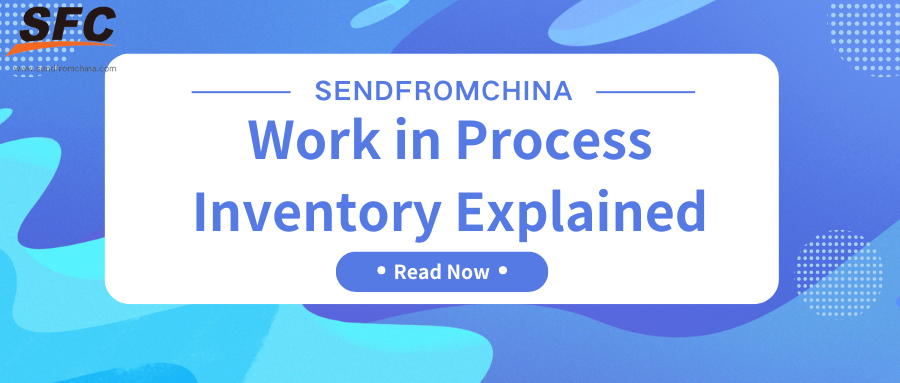Table of Contents
Work in Process Inventory Explained: Meaning, Formula, and Importance
Time: Jun 06,2025 Author: SFC Source: www.sendfromchina.com
In the intricate world of manufacturing and production, inventory management plays a pivotal role in ensuring operational efficiency and financial accuracy. Among the various types of inventory, Work in Process (WIP) inventory holds a unique position. It represents the goods that are in the midst of the production process—neither raw materials nor finished products.Understanding WIP inventory is essential for manufacturers aiming to optimize their production processes, manage costs effectively, and maintain accurate financial records. It serves as a critical indicator of a company's production efficiency and can significantly impact the bottom line.
In this comprehensive guide, we will delve into the concept of Work in Process inventory, exploring its components, calculation methods, significance in the manufacturing process, and strategies for optimization. By gaining a deeper understanding of WIP inventory, businesses can enhance their production workflows, reduce waste, and improve overall profitability.
Whether you're a seasoned manufacturing professional or new to the field, this article aims to provide valuable insights into managing WIP inventory effectively. Let's embark on this journey to unravel the complexities of Work in Process inventory and discover how to leverage it for operational excellence.

1. What is Work in Process (WIP) Inventory?
Work in Process inventory refers to partially completed goods that are still undergoing the manufacturing process but are not yet ready for sale. These items have moved beyond the raw materials stage and are in various phases of production, awaiting completion.WIP inventory is a critical component of a company's current assets, as it represents the investment in materials, labor, and overhead costs for products that are in the process of being manufactured. Accurately accounting for WIP inventory is essential for financial reporting and assessing production efficiency.
In accounting, WIP inventory is recorded on the balance sheet under the inventory section. It includes the costs of raw materials, direct labor, and allocated manufacturing overhead associated with the unfinished goods. Once the manufacturing process is complete, the costs are transferred from WIP inventory to finished goods inventory, and eventually to the cost of goods sold (COGS) upon sale.
Understanding and managing WIP inventory is vital for manufacturers to ensure efficient production processes, accurate financial statements, and effective inventory control. By monitoring WIP levels, companies can identify bottlenecks, optimize resource allocation, and improve overall operational performance.
2. Components of Work in Process Inventory
Work in Process inventory comprises three fundamental cost components: direct materials, direct labor, and manufacturing overhead. Each plays a vital role in determining the total value of products that are partially completed within the production cycle.
Direct Materials
Direct materials are the raw inputs that are physically incorporated into the final product. These materials can be directly traced to specific units of production. For instance, in furniture manufacturing, wood and upholstery fabric are considered direct materials. Accurate tracking of direct materials is essential for cost control and inventory valuation.Direct Labor
Direct labor refers to the wages and related costs of employees who are directly involved in the manufacturing process. This includes workers who assemble products, operate machinery, or perform tasks that can be directly attributed to specific units of output. Proper allocation of direct labor costs ensures precise product costing and aids in performance evaluation.Manufacturing Overhead
Manufacturing overhead encompasses all indirect costs associated with the production process that cannot be directly traced to specific products. This includes expenses such as factory utilities, equipment depreciation, maintenance, and salaries of supervisory personnel. Allocating manufacturing overhead accurately is crucial for determining the full cost of production and for setting appropriate pricing strategies.3. How to Calculate Work in Process Inventory?
Calculating Work in Process inventory is essential for manufacturers to accurately assess production costs and manage financial reporting. WIP inventory represents the value of products that are partially completed at a specific point in time.
WIP Inventory Formula
The standard formula to calculate WIP inventory is:Ending WIP Inventory = Beginning WIP Inventory + Manufacturing Costs – Cost of Goods Manufactured (COGM)
Where:
- Beginning WIP Inventory: The value of WIP inventory at the start of the accounting period.
- Manufacturing Costs: The total costs incurred during the production process, including direct materials, direct labor, and manufacturing overhead.
- Cost of Goods Manufactured (COGM): The total cost of goods that have been completed during the period.
Example Calculation
Suppose a company has the following data for a fiscal year:- Beginning WIP Inventory: $20,000
- Manufacturing Costs: $250,000
- COGM: $245,000
Applying the formula:
Ending WIP Inventory = $20,000 + $250,000 – $245,000 = $25,000
This calculation indicates that the company has $25,000 worth of products still in the production process at the end of the period.
Key Considerations
- Accurate Data Collection: Ensure all components—beginning inventory, manufacturing costs, and COGM—are accurately recorded.- Regular Monitoring: Regularly calculate WIP inventory to maintain up-to-date financial records and identify production inefficiencies.
- Integration with Financial Statements: WIP inventory is a component of current assets on the balance sheet and affects the cost of goods sold on the income statement.
By accurately calculating WIP inventory, businesses can gain insights into their production processes, manage costs effectively, and make informed financial decisions.
4. Why Work in Process Inventory Matters
Work in Process inventory plays a pivotal role in the manufacturing sector, serving as a barometer for production efficiency, financial health, and customer satisfaction. Proper management of WIP inventory can lead to significant improvements in operational performance and profitability.
Enhancing Production Efficiency
WIP inventory provides insights into the flow of production processes. By monitoring WIP levels, manufacturers can identify bottlenecks—points in the production line where work accumulates due to slower processing speeds. Addressing these bottlenecks ensures a smoother production flow, reducing idle time and increasing throughput. For instance, if a particular workstation consistently has a high volume of WIP, it may indicate a need for additional resources or process improvements at that stage.Accurate Financial Reporting
In accounting, WIP inventory is classified as a current asset on the balance sheet. Accurate valuation of WIP is essential for reflecting the true financial position of a company. Overstating or understating WIP can lead to misrepresented cost of goods sold (COGS) and net income figures. Regular assessment and precise calculation of WIP ensure compliance with accounting standards and provide stakeholders with reliable financial information.Cost Management and Reduction
Managing WIP inventory effectively contributes to cost control. Excessive WIP levels can tie up capital in unfinished goods, leading to increased holding costs and potential obsolescence. By optimizing WIP, companies can reduce storage expenses, minimize waste, and allocate resources more efficiently. Implementing lean manufacturing principles, such as just-in-time (JIT) production, can help maintain optimal WIP levels and reduce unnecessary expenditures.Meeting Customer Demand
WIP inventory directly impacts a company's ability to meet customer demand promptly. Efficient management ensures that products move swiftly through the production process, reducing lead times and enabling timely deliveries. Conversely, poor WIP management can result in delays, backorders, and dissatisfied customers. By maintaining appropriate WIP levels, manufacturers can enhance customer satisfaction and foster long-term relationships.Supporting Strategic Decision-Making
WIP inventory data provides valuable insights for strategic planning and decision-making. Analyzing WIP trends can reveal areas for process improvement, capacity planning, and investment opportunities. For example, consistently high WIP levels at a particular stage may indicate the need for equipment upgrades or additional workforce training. Informed decisions based on WIP analysis can lead to increased efficiency and competitive advantage.5. How to Optimize Work in Process Inventory?
Effectively managing Work in Process inventory is crucial for manufacturers aiming to enhance operational efficiency, reduce costs, and improve product quality. By implementing strategic practices, businesses can streamline production processes and maintain optimal inventory levels.
Implement Lean Manufacturing Principles
Adopting lean manufacturing techniques helps eliminate waste and improve workflow. Practices such as Just-in-Time production ensure materials and components are available only as needed, reducing excess inventory and minimizing holding costs.Utilize Real-Time Data and Technology
Leveraging real-time data through technologies like Internet of Things (IoT) devices and manufacturing execution systems (MES) provides visibility into production processes. This enables prompt identification of bottlenecks and facilitates timely decision-making to optimize WIP levels.Conduct Regular Audits and Cycle Counting
Regular audits and cycle counting help maintain accurate inventory records, ensuring discrepancies are identified and addressed promptly. This practice supports better forecasting and inventory planning, reducing the risk of overproduction or stockouts.Optimize Production Scheduling
Efficient production scheduling aligns manufacturing activities with demand forecasts, preventing the accumulation of excessive WIP inventory. Techniques such as Material Requirements Planning (MRP) assist in coordinating production schedules with inventory needs.Enhance Supply Chain Coordination
Collaborating closely with suppliers ensures timely delivery of materials, reducing delays in the production process. Effective supply chain management contributes to maintaining optimal WIP levels and meeting customer demand efficiently.6. Conclusion
Work in Process inventory is a critical component of the manufacturing process, representing the investment in products that are not yet complete. Proper management of WIP inventory ensures accurate financial reporting, efficient production processes, and optimal use of resources. By understanding its components, calculation methods, and optimization strategies, businesses can enhance their operational efficiency and profitability.7. FAQs
Q1: Is WIP inventory considered a current asset?
Yes, WIP inventory is classified as a current asset on the balance sheet, as it is expected to be converted into finished goods within the operating cycle.Q2: How does WIP inventory differ from finished goods inventory?
WIP inventory includes products that are in the production process but not yet complete, whereas finished goods inventory comprises products that are completed and ready for sale.Q3: Can high WIP levels indicate production issues?
Yes, excessive WIP levels may suggest inefficiencies, such as production bottlenecks or overproduction, leading to increased holding costs.Q4: What industries typically have significant WIP inventory?
Industries with complex manufacturing processes, like automotive, electronics, and aerospace, often have substantial WIP inventories due to longer production cycles.Q5: How often should WIP inventory be evaluated?
WIP inventory should be assessed regularly, typically at the end of each accounting period, to ensure accurate financial reporting and effective inventory management. Post Views:1085
Post Views:1085
Copyright statement: The copyright of this article belongs to the original author. Please indicate the source for reprinting.
Previous Post
FCA vs. Other Incoterms: What Makes Free Carrier So Flexible?
Next Post
Fulfillment Center vs. Warehouse 2025: What Are the Differences
TAGS
Hot Research
Recent News
- Third Party Logistics Definition, Process, and Advantages
- What Is Ecommerce Fulfillment? The Definition, Process, and Benefits
- Where Does Shein Ship From
- What Is End-to-End Fulfillment and How Does It Work for Cross-Border Ecommerce?
- How to Reduce Cross-Border Shipping Costs When Sourcing from China
Get a Custom China Fulfillment Solution with FREE Storage for 30 Days
 Want to know about our services, fees or receive a custom quote?
Want to know about our services, fees or receive a custom quote?
 Please fill out the form on the right and we will get back to you within a business day.
Please fill out the form on the right and we will get back to you within a business day.
 The more information you provide, the better our initial response
will be.
The more information you provide, the better our initial response
will be.





 TAGS:
TAGS: